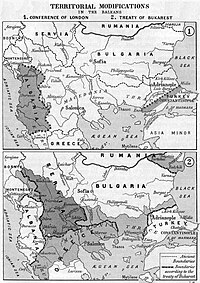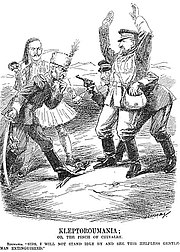Fördraget i Bukarest (1913)
| Fördraget i Bukarest | |
 gränsdragningar efter fördraget i London och fördraget i Bukarest | |
| Typ | multilateralt avtal |
|---|---|
| Innehåll | Fredsfördrag i Andra Balkankriget |
| Signerades | 10 augusti 1913 |
| Plats | Bukarest, Rumänien |
| Parter | 5 |
| Signerat av | Bulgarien, Rumänien, Serbien, Grekland, Montenegro |


Fördraget i Bukarest (rumänska: Tratatul de la Bucureşti; serbiska: Bukureštanski mir/ Букурештански мир; bulgariska: Договорът от Букурещ; grekiska: Συνθήκη του Βουκουρεστίου) undertecknades den 10 augusti 1913 av Bulgarien, Rumänien, Serbien, Grekland, Montenegro i Bukarest i Rumänien, och innebar slutet på Andra Balkankriget.[1]
Källor
- Den här artikeln är helt eller delvis baserad på material från engelskspråkiga Wikipedia, 12 maj 2014.
Fotnoter
- ^ Anderson, Frank Marby; Amos Shartle Hershey (1918). ”The Treaty of Bucharest, August 10, 1913”. Handbook for the Diplomatic History of Europe, Asia, and Africa 1870-1914. Washington, DC: National Board for Historical Service, Government Printing Office
Externa länkar
 Wikimedia Commons har media som rör Fördraget i Bukarest (1913).
Wikimedia Commons har media som rör Fördraget i Bukarest (1913).
Media som används på denna webbplats
Bucharest Peace Conference delegates (1913). Among those pictured: Eleftherios Venizelos; Titu Maiorescu; Dimitar Tonchev; Constantin Dissescu; Nikolaos Politis; Alexandru Marghiloman; Danilo Kalafatović; Constantin Coandă; Constantin Cristescu; Take Ionescu; Miroslav Spalajkovic; and "T. Vukotich" (Janko Vukotić?).
KLEPTOROUMANIA.
Punch cartoon favourable to Bulgaria, the aggressor of the Second Balkan War. King Carol I of Romania points his pistol at King Petar of Serbia and King Constantine of Greece while he steals Southern Dobrudja from the helpless Tsar Ferdinand of Bulgaria.
The title "KLEPTOROUMANIA" is a pun on kleptomania, the mental disorder of impulsive stealing for the sake of stealing.


